Theme Parks & Themed Entertainment
Universal Creative tweaked the magical formula it used to create Hollywood’s Wizarding World of Harry Potter
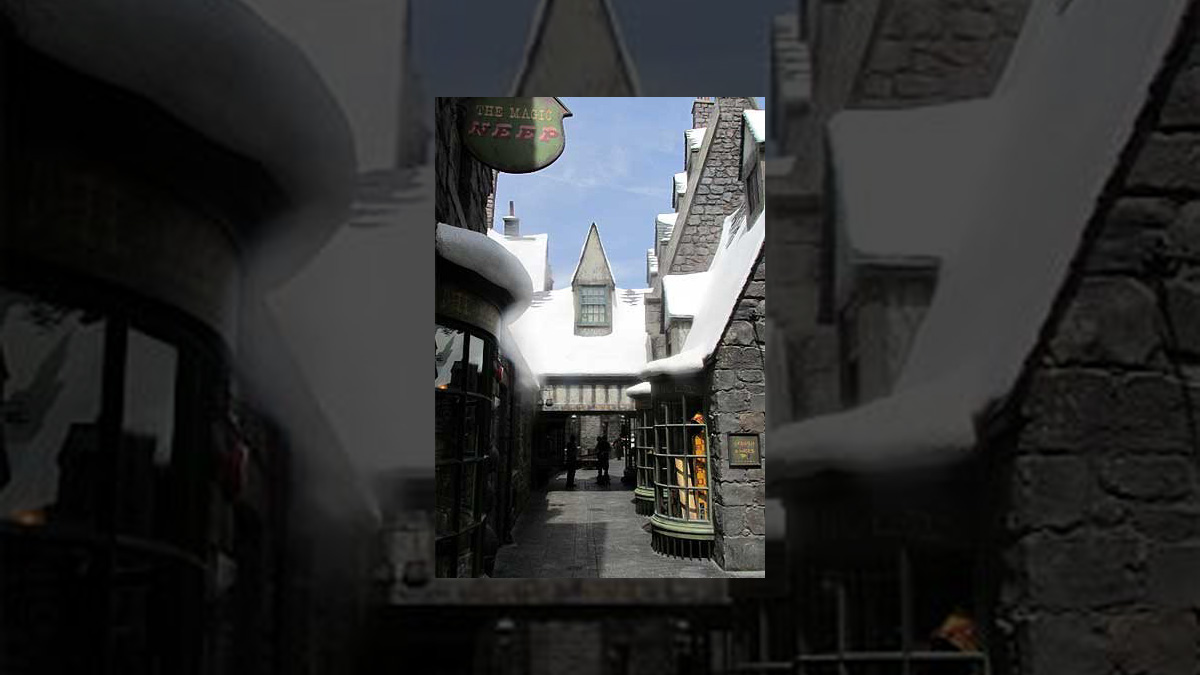
Given that there are already Wizarding Worlds in Orlando & Osaka, why should Harry Potter fans now travel to Hollywood to experience the third theme park incarnation of that magical realm which J.K. Rowling dreamed up?
Because — as Professor Flitwick (who teaches the Charms class at Hogwarts School of Witchcraft and Wizardry) might say — the third time’s the charm. Universal Creative took all of the lessons that they learned while creating the original Wizarding World of Harry Potter for Universal’s Islands of Adventure (not to mention all of the tweaks and refinements that were made for the versions of Hogwarts Castle & Hogsmeade which were conjured up for Universal Studios Japan back in July of 2014). The end result is that Universal Studios Hollywood‘s version of The Wizarding World of Harry Potter (which officially opened to the public earlier this morning) may be the most immersive, hyper-detailed theme park environment ever created.
You see, even though the two earlier versions of The Wizarding World have been hugely popular with theme park goers all over the globe, given that this one was being built in Hollywood (i.e., the movie-making magic capital of the world), Universal Creative really felt that they had to step up their game. So this time around, no detail was too small to reconsider or revisit. Take — for example — the faux snow that covers the rooftops of Hogsmeade Village.
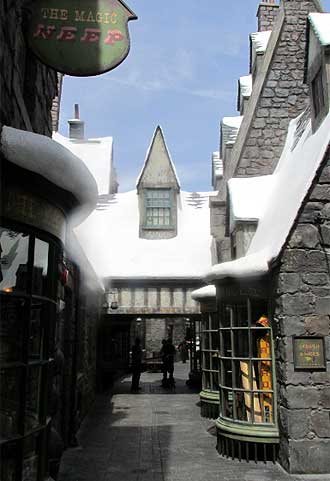 Photo by Jim Hill
Photo by Jim Hill
“Since we built the first Wizarding World in Orlando, some of our production & design techniques have been richly enhanced. Which is why we decided to change the way that the snow sits of the roofs out here in Hollywood. We wanted things to look as real as they possibly could in this version of Hogsmeade. Which is why we even changed the way we formed the icicles that hang down from so many of the village’s rooftops and window sills,” said Stuart Craig, the production designer of all the “Harry Potter” films. Who — at J.K. Rowling’s personal request — worked with Universal Creative to translate the characters & settings from the 7 “Potter” books & 8 motion pictures into one truly immersive theme park experience.
Mind you, one of the main reasons that the Universal Creative revisited many of the design choices that they’d made with the Orlando & Osaka versions of the Wizarding World was Southern California’s strong sunlight. The very sunlight that convinced motion picture pioneer Carl Laemmle that 230 acres of ranchland high up in the Hollywood Hills would be the perfect spot to build a silent film studio — one Universal City — back in 1915. But as far as Alan Gilmore (i.e., the supervising art director for the “Harry Potter” films as well as all four of the Wizarding Worlds that have been built to date) is concerned, that super-strong sunlight was both a blessing and a curse.
“The quality of light here in Southern California is amazing. It’s so vivid. It almost feels like hi-def when you look at objects here. Which is why — as we were designing the Wizarding World for Universal Studios Hollywood — we knew that we had to take the almost unforgiving quality of that sunlight into account. Which is why we enhanced a lot of the colors & the textures that we used on the West Coast version of Hogwarts Castle & Hogsmeade. So that they’d then look as good as they should in this particular setting,” said Alan.
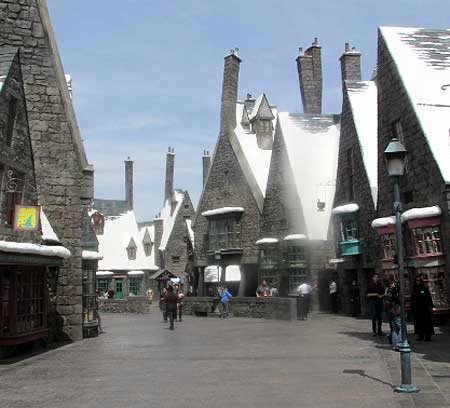 Photo by Jim Hill
Photo by Jim Hill
Of course, there were some advantages to being able to build The Wizarding World of Harry Potter on the Upper Lot at Universal Studios Hollywood. Chief among them being that Hogwarts Castle was now surrounded by the Hollywood Hills, which could then stand in for the Scottish Highlands. Which — to hear J.K. Rowling tell the tale — is where Harry Potter’s alma mater has been hidden away from the prying eyes of Muggles.
“Back in the Fall of 2010 when we first began designing this version of the Wizarding World back in London, we built models of the whole terrain in & around Universal Studios Hollywood. We built both computer models and physical models just so we could then determine the best possible positioning for Hogwarts Castle,” Gilmore continued. “We actually designed views to take advantage of the way this version of the castle would sit up in the Hollywood Hills. Take — for example — when the queue for ‘Forbidden Journey’ passes through the space where Madam Sprout teaches her Herbology classes. As guests move through those greenhouses at the back of the castle, they’re going to get this lovely view of the nearby mountain tops.”
And speaking of things to view … Those who have previously experienced the original 2D version of “Harry Potter and the Forbidden Journey” will be in for something of a shock once they climb aboard one of Universal Hollywood’s flying benches. For — as Thierry Coup (i.e., the SVP of Universal Creative) explains — they actually went back into that ride film (which was shot in 2008, right after production of “Harry Potter and the Half-Blood Prince” had wrapped) and added a lot of brand-new 3D elements.
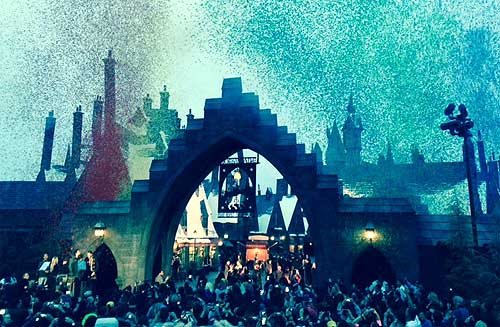 Photo by Jim Hill
Photo by Jim Hill
“Take — for example — the first flying scene over Hogwarts Castle. Thanks to 3D-HD, we were able to go back into that ride film and make it seem as though that dragon was now getting much, much closer to the guests. Even closer than we had him before,” Thierry enthused. “And we did the same thing with the snitch in the quidditch match. Also the dementors. Thanks to the way we’ve used 3D to enhance this ride film, the dementors now get right up in your face and you can feel their breath.”
And to make sure that this new hyper-realistic 3D-HD version of the “Harry Potter and the Forbidden Journey” ride film fits in seamlessly with the rest of this attraction, Universal Creative has gone through and added more sets, scenery & detailing to Hogwarts Castle. With the end result being that the USH’s version of this dark ride is now the most immersive version of “Forbidden Journey” on the planet.
“We had gotten such a positive response from all of the guests who rode this attraction in Orlando & Osaka that — when it came to Hollywood — we wanted to try and raise the bar one more time. Which is why — as you’ve been on this attraction before and are now riding your flying bench through USH’s version of the Forbidden Forest — you’ll notice that we’ve expanded that forest. Likewise the Chamber of Secrets. We added a lot more sets to that section of the attraction as well,” Coup continued. “A lot of theme park fans already thought that ‘Forbidden Journey’ was one of the best dark rides out there. With the changes that we made to the Hollywood version of this attraction, we were hoping that we could turn it into the ultimate immersive experience.”
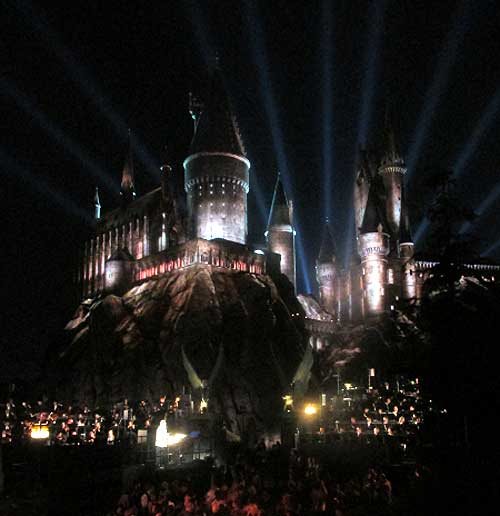 Photo by Jim Hill
Photo by Jim Hill
And the plussing continued in other parts of Hogwarts Castle. To make sure that this was the most authentic version of the Wizarding World produced to date, Universal Creative — working with their partners at Warner Bros. — has placed props that were used in the production of the eight “Harry Potter” films in various spots around this enormous show building.
“Take — for example — in the Dark Arts class in Hogwarts, we have the actual desks from that set. And the chalkboard in there is the original chalkboard as well,” Gilmore said. “What’s really great is that Universal Creative’s prop team has made props of such high quality is that they blend seamlessly with the film props. So it’s all one seamless place really.”
But — of course — because this is the version of The Wizarding World that was being built at Universal Hollywood … Well, since so many movie-making professionals would soon be coming by this theme park to see what all the fuss was about, it was absolutely crucial that that the various film tricks which Universal Creative used during the construction of this newest “Harry Potter” land be right on the money.
 Photo by Jim Hill
Photo by Jim Hill
“That’s why I just love the view the people get just as they come through the gates at Hogsmeade Village. We were able to do something in Hollywood that we just weren’t able to do in Orlando or Osaka. Which was position Hogwarts Castle in such a way that it actually looms up behind the village,” Thierry said. “Thanks to the brilliance of Stuart and Alan — plus a few classic film tricks like forced perspective — we were able to make Hogwarts Castle look as though it were 700 feet tall. That was our goal going into this project. And we’ve achieved it. It feels … Well, magical.”
And just so you know: This may not be the last time that Universal Creative refines its take on the Wizarding World. In the concept art that was released last February for Universal Studios Beijing, “Harry Potter” fans couldn’t help but notice that this 1000-acre / $3.3 project featured yet another version of Hogsmeade & Hogwarts Castle.
So how will the mainland China iteration of The Wizarding World of Harry Potter differ from the Orlando, Osaka and Hollywood versions? Well, short of taking Professor Trelawney’s divinations class, I guess that we’ll all just have to wait ’til 2019. Which is when the Universal Studios Beijing theme park and resort is supposed to open in the Tongzhou district to the east of China’s capital.
This article was originally posted on the Huffington Post’s Entertainment page on April 7, 2016
History
The Evolution and History of Mickey’s ToonTown

Disneyland in Anaheim, California, holds a special place in the hearts of Disney fans worldwide, I mean heck, it’s where the magic began after all. Over the years it’s become a place that people visit in search of memorable experiences. One fan favorite area of the park is Mickey’s Toontown, a unique land that lets guests step right into the colorful, “Toony” world of Disney animation. With the recent reimagining of the land and the introduction of Micky and Minnies Runaway Railway, have you ever wondered how this land came to be?
There is a fascinating backstory of how Mickey’s Toontown came into existence. It’s a tale of strategic vision, the influence of Disney executives, and a commitment to meeting the needs of Disney’s valued guests.
The Beginning: Mickey’s Birthdayland
The story of Mickey’s Toontown starts with Mickey’s Birthdayland at Walt Disney World’s Magic Kingdom. Opened in 1988 to celebrate Mickey Mouse’s 60th birthday, this temporary attraction was met with such overwhelming popularity that it inspired Disney executives to think bigger. The idea was to create a permanent, immersive land where guests could step into the animated world of Mickey Mouse and his friends.
In the early ’90s, Disneyland was in need of a refresh. Michael Eisner, the visionary leader of The Walt Disney Company at the time, had an audacious idea: create a brand-new land in Disneyland that would celebrate Disney characters in a whole new way. This was the birth of Mickey’s Toontown.
Initially, Disney’s creative minds toyed with various concepts, including the idea of crafting a 100-Acre Woods or a land inspired by the Muppets. However, the turning point came when they considered the success of “Who Framed Roger Rabbit.” This film’s popularity and the desire to capitalize on contemporary trends set the stage for Toontown’s creation.
From Concept to Reality: The Birth of Toontown
In 1993, Mickey’s Toontown opened its gates at Disneyland, marking the first time in Disney Park history where guests could experience a fully realized, three-dimensional world of animation. This new land was not just a collection of attractions but a living, breathing community where Disney characters “lived,” worked, and played.
Building Challenges: Innovative Solutions
The design of Mickey’s Toontown broke new ground in theme park aesthetics. Imagineers were tasked with bringing the two-dimensional world of cartoons into a three-dimensional space. This led to the creation of over 2000 custom-built props and structures that embodied the ‘squash and stretch’ principle of animation, giving Toontown its distinctiveness.
And then there was also the challenge of hiding the Team Disney Anaheim building, which bore a striking resemblance to a giant hotdog. The Imagineers had to think creatively, using balloon tests and imaginative landscaping to seamlessly integrate Toontown into the larger park.

Key Attractions: Bringing Animation to Life
Mickey’s Toontown featured several groundbreaking attractions. “Roger Rabbit’s Car Toon Spin,” inspired by the movie “Who Framed Roger Rabbit,” became a staple of Toontown, offering an innovative ride experience. Gadget’s Go-Coaster, though initially conceived as a Rescue Rangers-themed ride, became a hit with younger visitors, proving that innovative design could create memorable experiences for all ages.
Another crown jewel of Toontown is Mickey’s House, a walkthrough attraction that allowed guests to explore the home of Mickey Mouse himself. This attraction was more than just a house; it was a carefully crafted piece of Disney lore. The house was designed in the American Craftsman style, reflecting the era when Mickey would have theoretically purchased his first home in Hollywood. The attention to detail was meticulous, with over 2000 hand-crafted, custom-built props, ensuring that every corner of the house was brimming with character and charm. Interestingly, the design of Mickey’s House was inspired by a real home in Wichita Falls, making it a unique blend of real-world inspiration and Disney magic.
Mickey’s House also showcased Disney’s commitment to creating interactive and engaging experiences. Guests could make themselves at home, sitting in Mickey’s chair, listening to the radio, and exploring the many mementos and references to Mickey’s animated adventures throughout the years. This approach to attraction design – where storytelling and interactivity merged seamlessly – was a defining characteristic of ToonTown’s success.

Executive Decisions: Shaping ToonTown’s Unique Attractions
The development of Mickey’s Toontown wasn’t just about creative imagination; it was significantly influenced by strategic decisions from Disney executives. One notable input came from Jeffrey Katzenberg, who suggested incorporating a Rescue Rangers-themed ride. This idea was a reflection of the broader Disney strategy to integrate popular contemporary characters and themes into the park, ensuring that the attractions remained relevant and engaging for visitors.
In addition to Katzenberg’s influence, Frank Wells, the then-President of The Walt Disney Company, played a key role in the strategic launch of Toontown’s attractions. His decision to delay the opening of “Roger Rabbit’s Car Toon Spin” until a year after Toontown’s debut was a calculated move. It was designed to maintain public interest in the park by offering new experiences over time, thereby giving guests more reasons to return to Disneyland.
These executive decisions highlight the careful planning and foresight that went into making Toontown a dynamic and continuously appealing part of Disneyland. By integrating current trends and strategically planning the rollout of attractions, Disney executives ensured that Toontown would not only capture the hearts of visitors upon its opening but would continue to draw them back for new experiences in the years to follow.
Global Influence: Toontown’s Worldwide Appeal
The concept of Mickey’s Toontown resonated so strongly that it was replicated at Tokyo Disneyland and influenced elements in Disneyland Paris and Hong Kong Disneyland. Each park’s version of Toontown maintained the core essence of the original while adapting to its cultural and logistical environment.
Evolution and Reimagining: Toontown Today
As we approach the present day, Mickey’s Toontown has recently undergone a significant reimagining to welcome “Mickey & Minnie’s Runaway Railway” in 2023. This refurbishment aimed to enhance the land’s interactivity and appeal to a new generation of Disney fans, all while retaining the charm that has made ToonTown a beloved destination for nearly three decades.

Dive Deeper into ToonTown’s Story
Want to know more about Mickey’s Toontown and hear some fascinating behind-the-scenes stories, then check out the latest episode of Disney Unpacked on Patreon @JimHillMedia. In this episode, the main Imagineer who worked on the Toontown project shares lots of interesting stories and details that you can’t find anywhere else. It’s full of great information and fun facts, so be sure to give it a listen!
History
Unpacking the History of the Pixar Place Hotel

Pixar Place Hotel, the newly unveiled 15-story tower at the Disneyland Resort, has been making waves in the Disney community. With its unique Pixar-themed design, it promises to be a favorite among visitors.
However, before we delve into this exciting addition to the Disneyland Resort, let’s take a look at the fascinating history of this remarkable hotel.
The Emergence of the Disneyland Hotel
To truly appreciate the story of the Pixar Place Hotel, we must turn back the clock to the early days of Disneyland. While Walt Disney had the visionary ideas and funding to create the iconic theme park, he faced a challenge when it came to providing accommodations for the park’s visitors. This is where his friend Jack Wrather enters the picture.
Jack Wrather, a fellow pioneer in the television industry, stepped in to assist Walt Disney in realizing his dream. Thanks to the success of the “Lassie” TV show produced by Wrather’s company, he had the financial means to build a hotel right across from Disneyland.
The result was the Disneyland Hotel, which opened its doors in October 1955. Interestingly, the early incarnation of this hotel had more of a motel feel than a hotel, with two-story buildings reminiscent of the roadside motels popular during the 1950s. The initial Disneyland Hotel consisted of modest structures that catered to visitors looking for affordable lodging close to the park. While the rooms were basic, it marked the beginning of something extraordinary.
The Evolution: From Emerald of Anaheim to Paradise Pier
As Disneyland’s popularity continued to soar, so did the demand for expansion and improved accommodations. In 1962, the addition of an 11-story tower transformed the Disneyland Hotel, marking a significant transition from a motel to a full-fledged hotel.
The addition of the 11-story tower elevated the Disneyland Hotel into a more prominent presence on the Anaheim skyline. At the time, it was the tallest structure in all of Orange County. The hotel’s prime location across from Disneyland made it an ideal choice for visitors. With the introduction of the monorail linking the park and the hotel, accessibility became even more convenient. Unique features like the Japanese-themed reflecting pools added to the hotel’s charm, reflecting a cultural influence that extended beyond Disney’s borders.
Japanese Tourism and Its Impact
During the 1960s and 1970s, Disneyland was attracting visitors from all corners of the world, including Japan. A significant number of Japanese tourists flocked to Anaheim to experience Walt Disney’s creation. To cater to this growing market, it wasn’t just the Disneyland Hotel that aimed to capture the attention of Japanese tourists. The Japanese Village in Buena Park, inspired by a similar attraction in Nara, Japan, was another significant spot.
These attractions sought to provide a taste of Japanese culture and hospitality, showcasing elements like tea ceremonies and beautiful ponds with rare carp and black swans. However, the Japanese Village closed its doors in 1975, likely due to the highly competitive nature of the Southern California tourist market.
The Emergence of the Emerald of Anaheim
With the surge in Japanese tourism, an opportunity arose—the construction of the Emerald of Anaheim, later known as the Disneyland Pacific Hotel. In May 1984, this 15-story hotel opened its doors.
What made the Emerald unique was its ownership. It was built not by The Walt Disney Company or the Oriental Land Company (which operated Tokyo Disneyland) but by the Tokyu Group. This group of Japanese businessmen already had a pair of hotels in Hawaii and saw potential in Anaheim’s proximity to Disneyland. Thus, they decided to embark on this new venture, specifically designed to cater to Japanese tourists looking to experience Southern California.
Financial Challenges and a Changing Landscape
The late 1980s brought about two significant financial crises in Japan—the crash of the NIKKEI stock market and the collapse of the Japanese real estate market. These crises had far-reaching effects, causing Japanese tourists to postpone or cancel their trips to the United States. As a result, reservations at the Emerald of Anaheim dwindled.
To adapt to these challenging times, the Tokyu Group merged the Emerald brand with its Pacific hotel chain, attempting to weather the storm. However, the financial turmoil took its toll on the Emerald, and changes were imminent.
The Transition to the Disneyland Pacific Hotel
In 1995, The Walt Disney Company took a significant step by purchasing the hotel formerly known as the Emerald of Anaheim for $35 million. This acquisition marked a change in the hotel’s fortunes. With Disney now in control, the hotel underwent a name change, becoming the Disneyland Pacific Hotel.
Transformation to Paradise Pier
The next phase of transformation occurred when Disney decided to rebrand the hotel as Paradise Pier Hotel. This decision aligned with Disney’s broader vision for the Disneyland Resort.
While the structural changes were limited, the hotel underwent a significant cosmetic makeover. Its exterior was painted to complement the color scheme of Paradise Pier, and wave-shaped crenellations adorned the rooftop, creating an illusion of seaside charm. This transformation was Disney’s attempt to seamlessly integrate the hotel into the Paradise Pier theme of Disney’s California Adventure Park.
Looking Beyond Paradise Pier: The Shift to Pixar Place
In 2018, Disneyland Resort rebranded Paradise Pier as Pixar Pier, a thematic area dedicated to celebrating the beloved characters and stories from Pixar Animation Studios. As a part of this transition, it became evident that the hotel formally known as the Disneyland Pacific Hotel could no longer maintain its Paradise Pier theme.
With Pixar Pier in full swing and two successful Pixar-themed hotels (Toy Story Hotels in Shanghai Disneyland and Tokyo Disneyland), Disney decided to embark on a new venture—a hotel that would celebrate the vast world of Pixar. The result is Pixar Place Hotel, a 15-story tower that embraces the characters and stories from multiple Pixar movies and shorts. This fully Pixar-themed hotel is a first of its kind in the United States.
The Future of Pixar Place and Disneyland Resort
As we look ahead to the future, the Disneyland Resort continues to evolve. The recent news of a proposed $1.9 billion expansion as part of the Disneyland Forward project indicates that the area surrounding Pixar Place is expected to see further changes. Disneyland’s rich history and innovative spirit continue to shape its destiny.
In conclusion, the history of the Pixar Place Hotel is a testament to the ever-changing landscape of Disneyland Resort. From its humble beginnings as the Disneyland Hotel to its transformation into the fully Pixar-themed Pixar Place Hotel, this establishment has undergone several iterations. As Disneyland Resort continues to grow and adapt, we can only imagine what exciting developments lie ahead for this iconic destination.
If you want to hear more stories about the History of the Pixar Place hotel, check our special edition of Disney Unpacked over on YouTube.
Stay tuned for more updates and developments as we continue to explore the fascinating world of Disney, one story at a time.
History
From Birthday Wishes to Toontown Dreams: How Toontown Came to Be

In the latest release of Episode 4 of Disney Unpacked, Len and I return, joined as always by Disney Imagineering legend, Jim Shull. This two-part episode covers all things Mickey’s Birthday Land and how it ultimately led to the inspiration behind Disneyland’s fan-favorite land, “Toontown”. But let’s not get ahead of ourselves here. It all starts in the early days at Disneyland.
Early Challenges in Meeting Mickey
Picture this: it’s the late 1970s and early 1980s, and you’re at Disneyland. You want to meet the one and only Mickey Mouse, but there’s no clear way to make it happen. You rely on Character Guides, those daily printed sheets that point you in Mickey’s general direction. But let’s be honest, it was like finding a needle in a haystack. Sometimes, you got lucky; other times, not so much.

Mickey’s Birthdayland: A Birthday Wish that Came True
Fast forward to the late 1980s. Disney World faced a big challenge. The Disney-MGM Studios Theme Park was under construction, with the company’s marketing machine in full swing, hyping up the opening of Walt Disney World’s third theme park, MGM Studios, in the Spring of 1989. This extensive marketing meant that many people were opting to postpone their family’s next trip to Walt Disney World until the following year. Walt Disney World needed something compelling to motivate guests to visit Florida in 1988, the year before Disney MGM Studios opened.
Enter stage left, Mickey’s Birthdayland. For the first time ever, an entire land was dedicated to a single character – and not just any character, but the mouse who started it all. Meeting Mickey was no longer a game of chance; it was practically guaranteed.

The Birth of Birthdayland: Creative Brilliance Meets Practicality
In this episode, we dissect the birth of Mickey’s Birthdayland, an initiative that went beyond celebrating a birthday. It was a calculated move, driven by guest feedback and a need to address issues dating back to 1971. Imagineers faced the monumental task of designing an experience that honored Mickey while efficiently managing the crowds. This required the perfect blend of creative flair and logistical prowess – a hallmark of Disney’s approach to theme park design.
Evolution: From Birthdayland to Toontown
The success of Mickey’s Birthdayland was a real game-changer, setting the stage for the birth of Toontown – an entire land that elevated character-centric areas to monumental new heights. Toontown wasn’t merely a spot to meet characters; it was an immersive experience that brought Disney animation to life. In the episode, we explore its innovative designs, playful architecture, and how every nook and cranny tells a story.

Impact on Disney Parks and Guests
Mickey’s Birthdayland and Toontown didn’t just reshape the physical landscape of Disney parks; they transformed the very essence of the guest experience. These lands introduced groundbreaking ways for visitors to connect with their beloved characters, making their Disney vacations even more unforgettable.
Beyond Attractions: A Cultural Influence
But the influence of these lands goes beyond mere attractions. Our episode delves into how Mickey’s Birthdayland and Toontown left an indelible mark on Disney’s culture, reflecting the company’s relentless dedication to innovation and guest satisfaction. It’s a journey into how a single idea can grow into a cherished cornerstone of the Disney Park experience.

Unwrapping the Full Story of Mickey’s Birthdayland
Our two-part episode of Disney Unpacked is available for your viewing pleasure on our Patreon page. And for those seeking a quicker Disney fix, we’ve got a condensed version waiting for you on our YouTube channel. Thank you for being a part of our Disney Unpacked community. Stay tuned for more episodes as we continue to “Unpack” the fascinating world of Disney, one story at a time.
-

 History11 months ago
History11 months ago31 Long-Gone Rides, Shows & Attractions at Disney-MGM (Hollywood Studios)
-

 News & Press Releases8 months ago
News & Press Releases8 months agoDisney Will Bring D23: The Ultimate Disney Fan Event to Anaheim, California in August 2024
-

 Theme Parks & Themed Entertainment12 months ago
Theme Parks & Themed Entertainment12 months agoFrom Aladdin to Indy – How Did We Get an Indiana Jones Stage Show at Disneyland?
-

 History4 months ago
History4 months agoFrom Birthday Wishes to Toontown Dreams: How Toontown Came to Be
-

 Theme Parks & Themed Entertainment12 months ago
Theme Parks & Themed Entertainment12 months agoHow Did We Get “Aladdin’s Oasis” at Disneyland?
-

 Film & Movies10 months ago
Film & Movies10 months ago“Indiana Jones and the Search for Indiana Jones”
-

 Theme Parks & Themed Entertainment10 months ago
Theme Parks & Themed Entertainment10 months agoWhen WDW Had a Racetrack – The Creation of the Walt Disney World Speedway
-

 History3 months ago
History3 months agoUnpacking the History of the Pixar Place Hotel









